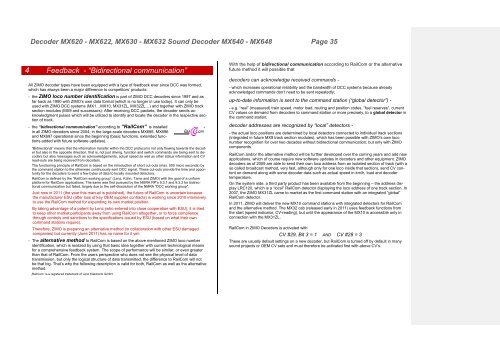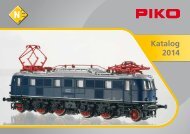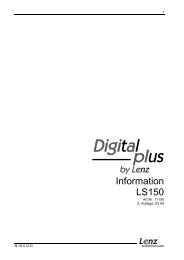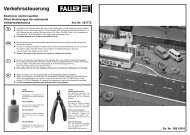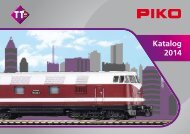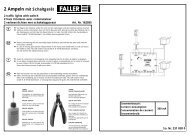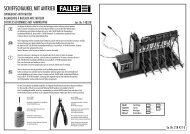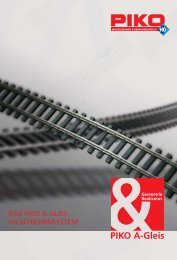INSTRUCTION MANUAL
INSTRUCTION MANUAL
INSTRUCTION MANUAL
You also want an ePaper? Increase the reach of your titles
YUMPU automatically turns print PDFs into web optimized ePapers that Google loves.
Decoder MX620 - MX622, MX630 - MX632 Sound Decoder MX640 - MX648 Page 35<br />
4 Feedback - “Bidirectional communication”<br />
All ZIMO decoder types have been equipped with a type of feedback ever since DCC was formed,<br />
which has always been a major difference to competitors’ products:<br />
- the ZIMO loco number identification is part of ZIMO DCC decoders since 1997 and as<br />
far back as 1990 with ZIMO’s own data format (which is no longer in use today). It can only be<br />
used with ZIMO DCC systems (MX1…MX10, MX31ZL, MX32ZL…) and together with ZIMO track<br />
section modules (MX9 and successors): After receiving DCC packets, the decoder sends acknowledgment<br />
pulses which will be utilized to identify and locate the decoder in the respective section<br />
of track.<br />
- the “bidirectional communication” according to “RailCom” is installed<br />
in all ZIMO decoders since 2004; in the large-scale decoders MX695, MX696<br />
and MX697 operational since the beginning (basic functions, extended functions<br />
added with future software updates).<br />
“Bidirectional” means that the information transfer within the DCC protocol is not only flowing towards the decoder<br />
but also in the opposite direction; that is, not just driving, function and switch commands are being sent to decoders<br />
but also messages such as acknowledgements, actual speed as well as other status information and CV<br />
read-outs are being received from decoders.<br />
The functioning principle of RailCom is based on the introduction of short cut-outs (max. 500 micro seconds) by<br />
the command station to the otherwise continuously sent DCC signal. These cut-outs provide the time and opportunity<br />
for the decoders to send a few bytes of data to locally mounted detectors.<br />
RailCom is defined by the “RailCom working group” (Lenz, Kühn, Tams and ZIMO) with the goal of a uniform<br />
platform for RailCom applications. The same was first pursued by the NMRA RP’s 9.3.1 and 9.3.2 for bidirectional<br />
communication but failed, largely due to the self-dissolution of the NMRA "DCC working group".<br />
Just now in 2011 (the year this manual is published), the future of RailCom is uncertain because<br />
the manufacturer ESU (after loss of key OEM supplier contracts) is working since 2010 intensively<br />
to use the RailCom method for expanding its own market position.<br />
By taking advantage of a patent by Lenz (who entered into close cooperation with ESU), it is tried<br />
to keep other market participants away from using RailCom altogether, or to force compliance<br />
through controls and sanctions to the specifications issued by ESU (based on what their own<br />
command stations require).<br />
Therefore, ZIMO is preparing an alternative method (in collaboration with other ESU damaged<br />
companies) but currently (June 2011) has no name for it yet:<br />
- The alternative method to RailCom is based on the above mentioned ZIMO loco number<br />
identification, which is realized by using that basic idea together with current technological means<br />
for a comprehensive feedback system. The scope of performance will be similar, or even greater<br />
than that of RailCom. From the users perspective who does not see the physical level of data<br />
transmission, but only the logical structure of data transmitted, the difference to RailCom will not<br />
be that big. That’s why the following description is valid for both, RailCom as well as the alternative<br />
method.<br />
„RailCom“ is a registered trademark of Lenz Elektronik GmbH.<br />
With the help of bidirectional communication according to RailCom or the alternative<br />
future method it will possible that<br />
decoders can acknowledge received commands -<br />
- which increases operational reliability and the bandwidth of DCC systems because already<br />
acknowledged commands don’t need to be sent repeatedly;<br />
up-to-date information is sent to the command station (“global detector”) -<br />
- e.g. “real” (measured) train speed, motor load, routing and position codes, “fuel reserves”, current<br />
CV values on demand from decoders to command station or more precisely, to a global detector in<br />
the command station;<br />
decoder addresses are recognized by “local” detectors -<br />
- the actual loco positions are determined by local detectors connected to individual track sections<br />
(integrated in future MX9 track section modules), which has been possible with ZIMO’s own loco<br />
number recognition for over two decades without bidirectional communication; but only with ZIMO<br />
components.<br />
RailCom and/or the alternative method will be further developed over the coming years and add new<br />
applications, which of course require new software updates in decoders and other equipment. ZIMO<br />
decoders as of 2009 are able to send their own loco address from an isolated section of track (with a<br />
so called broadcast method, very fast, although only for one loco inside that section), send CV content<br />
on demand along with some decoder data such as actual speed in km/h, load and decoder<br />
temperature.<br />
On the system side, a third party product has been available from the beginning – the address display<br />
LRC120, which is a “local” RailCom detector displaying the loco address of one track section. In<br />
2007, the ZIMO MX31ZL came to market as the first command station with an integrated “global”<br />
RailCom detector.<br />
In 2011, ZIMO will deliver the new MX10 command stations with integrated detectors for RailCom<br />
and the alternative method. The MX32 cab (released early in 2011) uses feedback functions from<br />
the start (speed indicator, CV-reading), but until the appearance of the MX10 is accessible only in<br />
connection with the MX31ZL.<br />
RailCom in ZIMO Decoders is activated with<br />
CV #29, Bit 3 = 1 AND CV #28 = 3<br />
These are usually default settings on a new decoder, but RailCom is turned off by default in many<br />
sound projects or OEM CV sets and must therefore be activated first with above CV’s.


